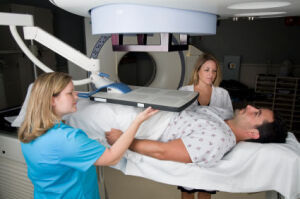by
Brendon Nafziger, DOTmed News Associate Editor | July 27, 2010
Most men get aggressive prostate cancer treatment even if they have low-risk disease, according to a new study.
A paper published Monday in Archives of Internal Medicine found most men diagnosed with cancer with low prostate-specific antigen levels still had their prostates removed or their tumors blasted with radiation, even though they were unlikely to have aggressive, high-risk cancers.
"There might be some degree of discrepancy between risk and the way that cancer's treated," Dr. Mark N. Stein told DOTmed News.




Ad Statistics
Times Displayed: 44170
Times Visited: 1362 Keep biomedical devices ready to go, so care teams can be ready to care for patients. GE HealthCare’s ReadySee™ helps overcome frustrations due to lack of network and device visibility, manual troubleshooting, and downtime.
Dr. Stein is a co-author of the study, a medical oncologist with the Cancer Institute of New Jersey and an assistant professor of medicine with UMDNJ-Robert Wood Johnson Medical School.
The authors caution that lowering the PSA cutoff levels used to determine whether to do a prostate biopsy could result in even larger numbers of men undergoing potentially unnecessary treatment.
While there's no strict cutoff for cancer risk, as deadly cancers can occur with nearly any PSA level, having PSA levels of 4 nanograms per milliliter is the typical trigger for getting a needle biopsy.
"Although abandoning an upper limit of normal for PSA level would allow physicians to detect more cancer, the benefits of diagnosing prostate cancer would likely be offset by treatment complications related to cancers that might never have caused harm," write the authors, led by Yu-Hsuan Shao, also with the New Brunswick, N.J.-based Cancer Institute of New Jersey.
In what the researchers call one of the largest studies of its kind, they examined results of 123,934 men diagnosed with prostate cancer between 2004 and 2006, using data drawn from the Surveillance, Epidemiology and End Results system. Of these men diagnosed with prostate cancer, about 14 percent had PSA levels of 4 nanograms per milliliter or lower.
In this lower-PSA group, around 54 percent were classified as having a low-risk cancer, yet almost 75 percent underwent a radical prostatectomy, the total removal of the organ, or had radiation therapy, the report said.
"Despite their lower risk of having clinically significant disease, treatment rates for men with PSA values of 4.0 nanograms per milliliter or lower were comparable to those of men presenting with PSA values between 4 and 20 nanograms per milliliter," the authors wrote.
For those diagnosed with cancer, complete prostate removal was done on 44 percent of men with PSA levels of less than 4 nanograms per milliliter, while 38 percent of men with PSA values between 4.1 and 10 also had the surgery. Radiation therapy was performed on 33 percent of men with PSA values 4 or lower, and 40 percent between 4.1 and 10.

